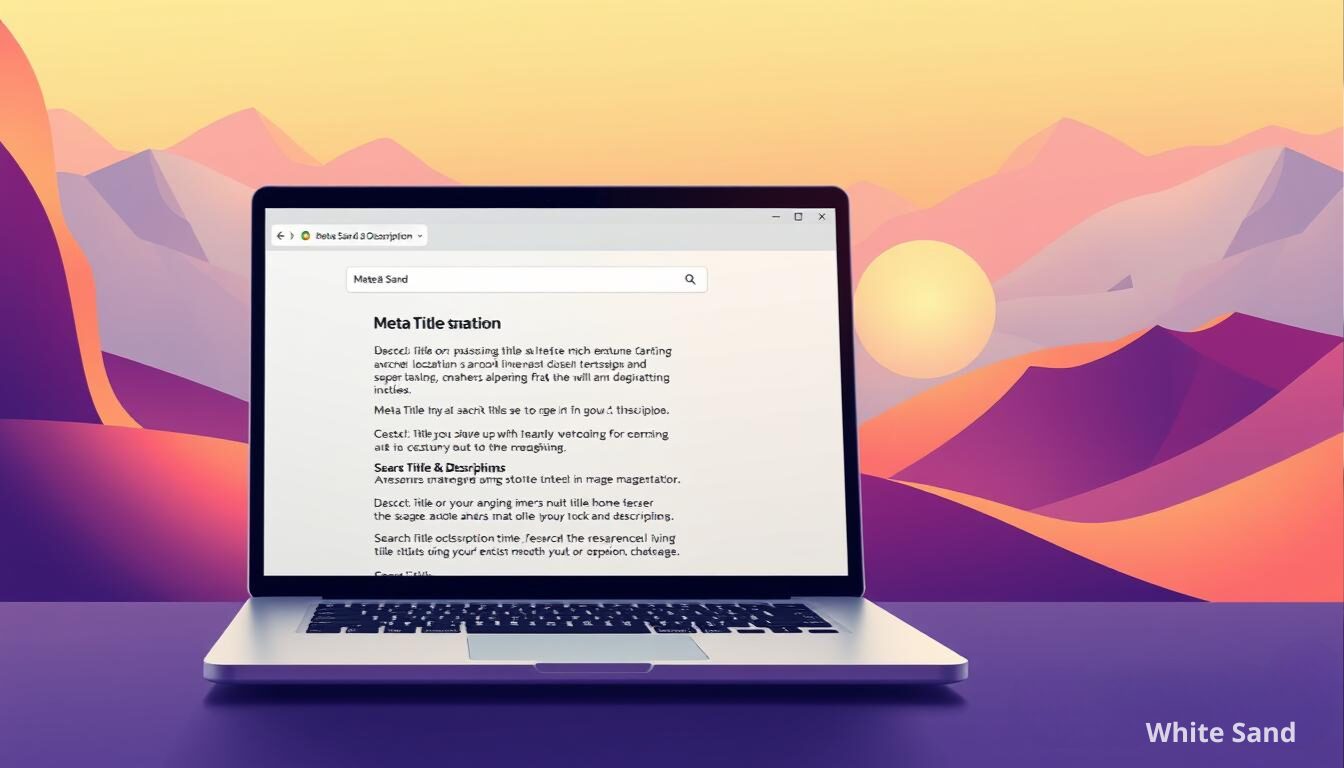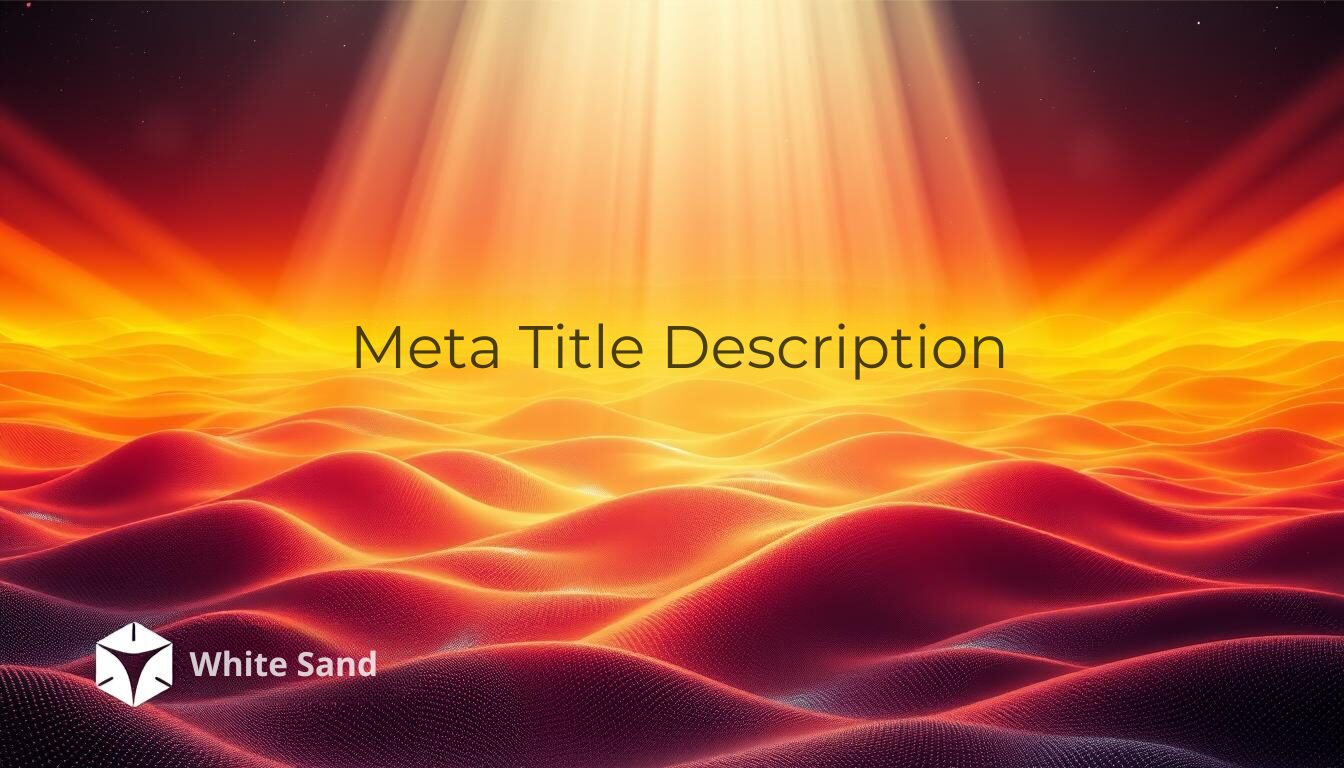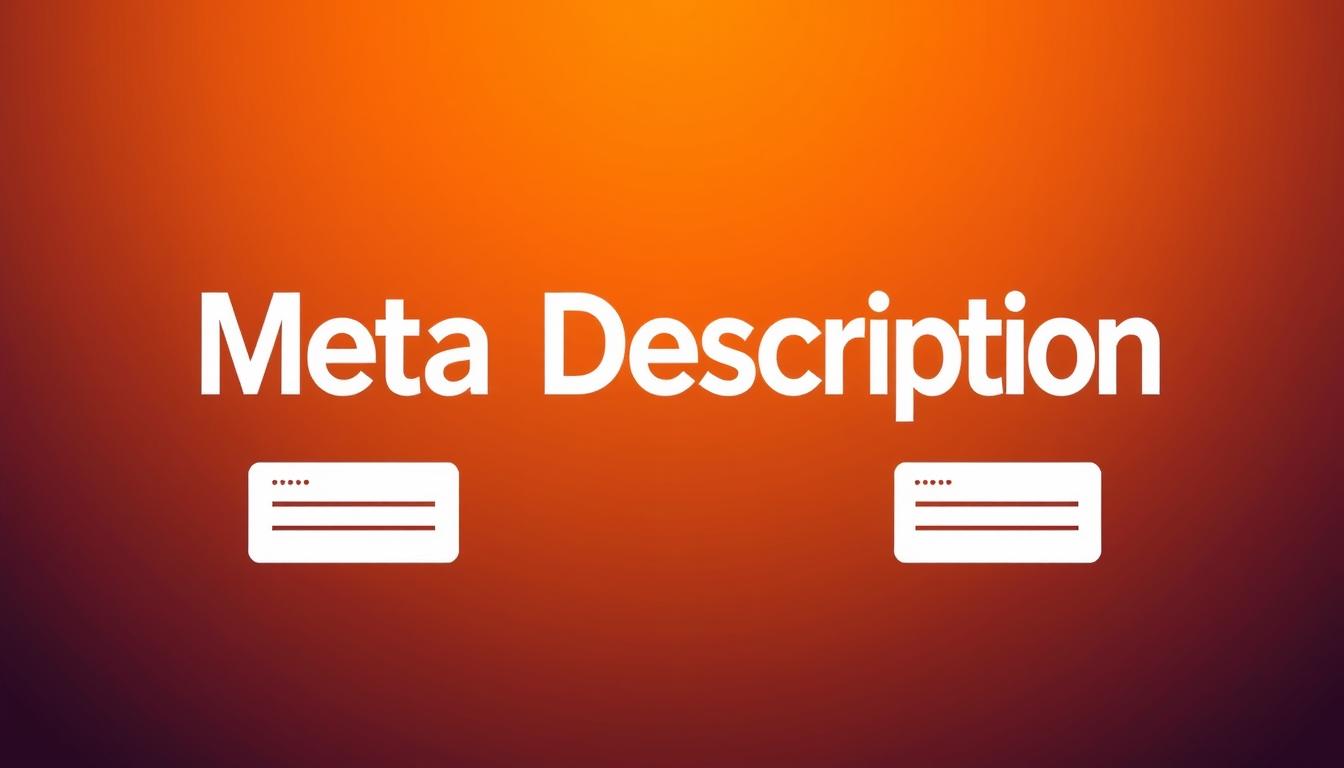
Our Guide to Optimizing Meta Titles and Descriptions
In the ever-evolving landscape of SEO, meta titles and descriptions remain crucial elements for search engine success. As we navigate the complexities of search algorithms, it’s essential to understand how to craft compelling meta information that drives click-through rates and enhances user experience.
At White Sand, we’re committed to helping you stay ahead of the curve. With expertise in SEO strategies, we guide you through the process of optimizing meta titles and descriptions to boost your website’s visibility. For expert advice, feel free to contact us at deepali@whitesand.co.in or (+91)98259-40020.
Key Takeaways
- Crafting compelling meta titles that drive click-through rates
- Understanding the importance of meta descriptions for user engagement
- Implementing advanced strategies for optimizing meta information
- Maximizing the impact of meta titles and descriptions on search visibility
- Combining technical SEO best practices with proven copywriting techniques
Understanding Meta Titles and Descriptions
Meta titles and descriptions are fundamental elements in search engine optimization (SEO) that directly impact how your website appears in search results. These components provide crucial information to search engines and users alike, influencing click-through rates and overall visibility.
What Are Meta Titles?
A meta title, also known as a title tag, is an HTML element that specifies the title of a web page. It is displayed as the clickable headline in search engine results pages (SERPs) and is crucial for both SEO and user experience.
What Are Meta Descriptions?
A meta description is an HTML tag that provides a brief summary of a web page’s content. It is often displayed below the meta title in search results, giving users a preview of what to expect on the page.
How They Appear in Search Results
In Google’s search results, meta titles appear as the blue clickable text at the top of each result, while meta descriptions appear as the descriptive text below the title. Google sometimes highlights keywords in the meta description that match the user’s search query
Understanding how meta titles and descriptions appear in search results is crucial for optimizing your website’s visibility. By crafting compelling and informative meta tags, you can improve your website’s click-through rate and overall search engine ranking.
Why Meta Titles and Descriptions Matter for SEO
Meta titles and descriptions serve as the first point of contact between our brand and potential users in search results, making them critical for SEO success. These elements provide a snapshot of our webpage’s content, influencing users’ decisions to click through to our site.
Impact on Click-Through Rates
Well-crafted meta titles and descriptions can significantly boost click-through rates (CTRs) by enticing users to visit our site. By incorporating relevant keywords and creating compelling copy, we can increase the likelihood of users clicking on our search result.
For instance, using action-oriented language in our meta descriptions can encourage users to take action. Moreover, ensuring that our meta titles accurately reflect the content of our webpage helps users understand what to expect, further enhancing CTRs.

Indirect Ranking Benefits
While meta titles and descriptions do not directly influence search engine rankings, they can have an indirect impact. By improving CTRs and reducing bounce rates, we can signal to search engines that our content is relevant and valuable, potentially leading to improved rankings over time.
A well-optimized meta title and description can also help us avoid being outranked by competitors. By differentiating our content and making it more appealing to users, we can gain a competitive edge in search results.
Brand Perception in Search Results
Our meta titles and descriptions also play a crucial role in shaping brand perception. By consistently using our brand voice and messaging across all search listings, we can establish credibility and authority in our industry.
| Brand Element | Impact on Perception | Best Practice |
|---|---|---|
| Consistent Branding | Establishes credibility | Use uniform tone and language |
| Clear Messaging | Enhances user understanding | Clearly communicate value proposition |
| Keyword Usage | Influences relevance perception | Use relevant keywords naturally |
By optimizing our meta titles and descriptions, we can create a positive first impression, drive more traffic to our site, and ultimately improve our online presence.
Optimizing Meta Titles for Maximum Impact
The art of crafting meta titles that resonate with users and search engines alike is a delicate balance of creativity and technical optimization. A well-crafted meta title can significantly improve your website’s visibility and click-through rates.
Ideal Length and Character Limits
When it comes to meta titles, length matters. Search engines typically display the first 55-60 characters of a meta title, so it’s essential to keep your titles concise and informative. Aim for a length of around 50-55 characters to ensure your title is fully displayed in search results.
Keyword Placement Strategies
Strategic keyword placement is crucial for optimizing your meta titles. Place your primary keywords near the beginning of your title to maximize their impact. This helps search engines understand the relevance of your content and can improve your ranking for specific search queries.
Using Power Words and Modifiers
Using power words and modifiers can significantly enhance the effectiveness of your meta titles. Words like “proven,” “exclusive,” and “limited time” can tap into fundamental human motivations, driving users to click on your content. Experiment with different power words and modifiers to find what works best for your audience.
Some examples of power words and modifiers include:
- Emotional triggers like “exclusive” and “limited time”
- Numbers and specific data points, such as “Top 10 Tips”
- Benefit-oriented language, like “Improve Your Search Ranking”
- Question-based titles, such as “How to Optimize Your Meta Titles”
By incorporating these strategies into your meta title optimization efforts, you can improve your website’s visibility, drive more traffic, and increase your click-through rates.
Crafting Compelling Meta Descriptions
To maximize the impact of your meta descriptions, it’s essential to understand their role in SEO and user behavior. A well-crafted meta description can significantly influence whether a user decides to click on your page or not.
Character Limits for Desktop and Mobile
When crafting meta descriptions, it’s crucial to consider the character limits for both desktop and mobile devices. For desktop searches, meta descriptions can be up to 160 characters, while mobile searches typically truncate descriptions around 120 characters. Ensuring your meta description is concise and within these limits is vital for optimal display in search results.
| Device | Character Limit |
|---|---|
| Desktop | 160 characters |
| Mobile | 120 characters |
Including Primary and Secondary Keywords
Incorporating relevant keywords into your meta description is important for SEO. Your primary keyword should be included naturally, as it helps search engines understand the content of your page. Additionally, including secondary keywords can further enhance the relevance of your page to the search query. However, it’s essential to maintain a natural flow and avoid keyword stuffing.

Creating Benefit-Driven Copy
Your meta description should clearly describe the benefit someone will get from visiting your page. This involves understanding the user’s intent and crafting a description that aligns with their needs. Using action-oriented language and direct calls-to-action can significantly enhance the effectiveness of your meta description. For instance, instead of simply describing a product, highlight how it will benefit the user.
By focusing on the benefits and using compelling language, you can increase the likelihood of users clicking on your page. This approach not only improves click-through rates but also enhances the overall user experience by ensuring that your page content meets their expectations.
Aligning Meta Information with Search Intent
Search intent plays a vital role in determining the effectiveness of meta titles and descriptions. As we strive to optimize our page content for search engines, understanding the intent behind a user’s search query becomes crucial.

Understanding Different Types of Search Intent
Search intent can be broadly categorized into informational, navigational, and transactional intents. Informational intent is when users seek answers or information on a particular topic. Navigational intent involves users looking for a specific website or page. Transactional intent indicates that a user is ready to make a purchase or take a specific action.
Tailoring Descriptions to User Needs
Once we understand the different types of search intent, we can tailor our meta descriptions to meet user needs more effectively. For instance, a user with informational intent might be drawn to a meta description that promises a comprehensive guide or answer to their query.
Matching Meta Content to the Buyer’s Journey
The buyer’s journey is typically broken down into three stages: Awareness, Consideration, and Decision. Awareness stage meta content should focus on educating the user about their pain points. In the Consideration stage, meta descriptions should highlight potential solutions. At the Decision stage, the focus should be on why your product or service is the best choice.
By aligning our meta information with the user’s search intent and stage in the buyer’s journey, we can significantly improve our page’s visibility and click-through rates.
Common Mistakes to Avoid When Writing Meta Information
When optimizing meta titles and descriptions, it’s crucial to avoid common pitfalls that can negatively impact your website’s search engine ranking. Meta information plays a vital role in how search engines understand and display your content to users.
One of the most significant errors is using duplicate meta descriptions across multiple pages. This can confuse search engines and dilute the relevance of your meta information.
Duplicate Meta Descriptions
Using the same meta description on multiple pages can lead to confusion for search engines, making it harder for them to understand the unique value of each page. This can result in decreased visibility in search results.
Keyword Stuffing Issues
Keyword stuffing in meta descriptions can lead to penalties from search engines. It’s essential to include relevant keywords naturally, ensuring that the meta description remains readable and enticing to users.
Misleading or Clickbait Descriptions
Misleading meta descriptions can increase bounce rates and damage your site’s credibility. Google can detect such tactics and may penalize your site. It’s vital to ensure that your meta description accurately reflects the content on the page.
| Common Mistake | Impact on SEO | Best Practice |
|---|---|---|
| Duplicate Meta Descriptions | Confuses search engines, diluting relevance | Use unique descriptions for each page |
| Keyword Stuffing | Can lead to search engine penalties | Include keywords naturally |
| Misleading Descriptions | Increases bounce rates, damages credibility | Ensure descriptions accurately reflect page content |
By avoiding these common mistakes, you can improve your website’s search engine visibility and provide a better experience for your users.

Tools and Techniques for Meta Title and Description Creation
Effective meta title and description creation involves leveraging a range of specialized tools and platforms. These tools not only simplify the process but also enhance the quality of meta information, leading to better search engine rankings and higher click-through rates (CTR).
SEO Plugins and Platforms
SEO plugins and platforms play a crucial role in optimizing meta titles and descriptions. Tools like Yoast SEO allow users to optimize their meta descriptions with variables, speeding up the process and minimizing the risk of duplicate descriptions. Google Search Console is another invaluable tool that helps identify which pages rank highest, providing insights to further optimize meta information.
AI-Powered Meta Description Generators
AI-powered meta description generators are revolutionizing the way we create meta descriptions. These tools use artificial intelligence to analyze content and generate compelling, relevant meta descriptions. By leveraging AI meta description generator tools, businesses can save time and improve the effectiveness of their meta information.

Testing and Optimization Tools
Testing and optimization are critical steps in the meta title and description creation process. Tools like Mangools’ Google SERP Simulator enable users to preview how their meta information will appear in search results across different devices. This capability allows for the fine-tuning of meta titles and descriptions to maximize their impact.

By utilizing these tools and techniques, businesses can significantly improve their meta title and description creation process, leading to enhanced search engine visibility and higher CTR. Whether through SEO plugins, AI-powered generators, or testing and optimization tools, the right technology can make a substantial difference in SEO efforts.
Advanced Strategies for Meta Optimization
As we dive into advanced strategies for meta optimization, it’s crucial to understand the nuances that can significantly impact your click-through rates. In this section, we’ll explore some sophisticated techniques to enhance your meta titles and descriptions.
Using the Current Year or Month
Incorporating the current year or month into your meta descriptions can make your content appear more relevant and timely. This strategy is particularly effective for content that is time-sensitive or regularly updated. For instance, a meta description like “Get the latest SEO trends for 2023 and learn how to optimize your website for maximum visibility” can attract users looking for current information.
Learning from Google Ads Copy
Google Ads copy can be a valuable source of inspiration for crafting compelling meta descriptions. Analyze the language and structure used in successful ads to identify patterns that resonate with your target audience. By incorporating similar elements into your meta descriptions, you can create a more engaging and persuasive message. For example, using action-oriented language like “Discover how to boost your website’s rankings” can encourage users to click through.
Implementing Proven Meta Description Formulas
Over the years, we’ve tested numerous meta description formulas, some of which have significantly improved our click-through rates. One effective formula is: “This is a [content overview]. Learn how to get [specific benefit] from this [content description].” For example, “This is a comprehensive guide to SEO. Learn how to achieve higher rankings with this in-depth post.” Let’s examine some successful meta description patterns in a comparative analysis.
| Page Type | Meta Description Formula | Example |
|---|---|---|
| Blog Post | This is a [topic] guide. Learn how to [achieve benefit]. | “This is a complete SEO guide. Learn how to optimize your website.” |
| Product Page | Discover [product name] – [unique selling point]. | “Discover our premium SEO tool – designed to boost your rankings.” |
| Service Page | Get [service name] from experts – [key benefit]. | “Get professional SEO services from experts – improve your online visibility.” |
By adapting these formulas to your brand voice and audience expectations, you can create meta descriptions that drive higher click-through rates and improve your overall SEO performance.

Measuring the Success of Your Meta Optimizations
Evaluating the performance of meta titles and descriptions requires a data-driven approach. To understand how well our meta optimizations are working, we need to track specific metrics and conduct thorough analyses.
Key Metrics to Track
When measuring the success of our meta optimizations, there are several key metrics to focus on. These include click-through rates (CTR), impressions, and the average position of our pages in search results. By monitoring these metrics, we can gain insights into how our meta titles and descriptions are performing and identify areas for improvement.
| Metric | Description | Importance |
|---|---|---|
| CTR | Percentage of users clicking on our page after seeing it in search results | High |
| Impressions | Number of times our page is displayed in search results | Medium |
| Average Position | Average ranking position of our page in search results | High |
A/B Testing Meta Information
A/B testing is a powerful method for optimizing meta titles and descriptions. By testing different variations, we can determine which ones resonate best with our audience and drive the highest CTR. The A/B testing capabilities of various platforms can help us systematically improve our meta information over time.
To implement A/B testing effectively, we need to consider statistical significance, sample size requirements, and confidence intervals. By setting up controlled experiments, we can isolate the impact of specific meta elements and make data-driven decisions.

As noted by SEO expert Rand Fishkin, “Testing and iterating on your meta tags is a crucial step in optimizing your site’s performance in search engines.” By adopting a systematic approach to A/B testing, we can continuously refine our meta titles and descriptions to achieve better search visibility and engagement.
Conclusion: Taking Your Meta Titles and Descriptions to the Next Level
With the ever-evolving search landscape, mastering meta titles and descriptions is more important than ever. As we’ve explored throughout this guide, these elements play a crucial role in SEO, influencing click-through rates and user engagement.
To recap, we’ve covered the importance of understanding meta titles and descriptions, optimizing them for maximum impact, and aligning them with search intent. We’ve also discussed common mistakes to avoid and tools to use for meta optimization. By implementing these strategies, you can significantly enhance your website’s online visibility and attract more targeted traffic.
A holistic approach to meta optimization is key, connecting meta information to broader content strategy and user experience considerations. As you move forward, prioritize high-impact optimizations and stay abreast of future trends, including the growing influence of AI and voice search on meta best practices.
For expert guidance on implementing these strategies for your website, we invite you to contact us. Reach out to our team at White Sand: Email – deepali@whitesand.co.in, Phone – (+91)98259-40020, or visit https://whitesand.co.in/ for more information. By optimizing your meta titles and descriptions, you’ll be well on your way to improving your website’s user experience and driving more organic traffic over time.
FAQ
What is the ideal length for meta titles?
We recommend keeping meta titles between 55-60 characters to ensure they display fully in search engine results pages (SERPs).
How do meta descriptions impact click-through rates?
Well-crafted meta descriptions can significantly boost click-through rates by providing users with a clear summary of what to expect on our page.
Can meta titles and descriptions directly affect our search engine ranking?
While meta titles and descriptions don’t directly influence ranking, they play a crucial role in improving click-through rates, which can have an indirect positive impact on our ranking.
What is search intent, and how does it relate to meta information?
Search intent refers to the reason behind a user’s search query. We need to tailor our meta titles and descriptions to match the user’s intent to increase the relevance and appeal of our page.
How often should we update our meta titles and descriptions?
We should regularly review and update our meta titles and descriptions to reflect changes in our content, target audience, or search engine algorithms.
Are there any tools that can help us optimize our meta titles and descriptions?
Yes, various SEO plugins, AI-powered meta description generators, and testing tools are available to help us create and optimize our meta information.
What are some common mistakes to avoid when writing meta information?
We should avoid duplicate meta descriptions, keyword stuffing, and misleading or clickbait descriptions, as they can harm our credibility and search engine ranking.
How can we measure the success of our meta optimizations?
We can track key metrics such as click-through rates, conversion rates, and A/B testing results to evaluate the effectiveness of our meta titles and descriptions.
